语言学概论复习重点
语言学概论复习资料
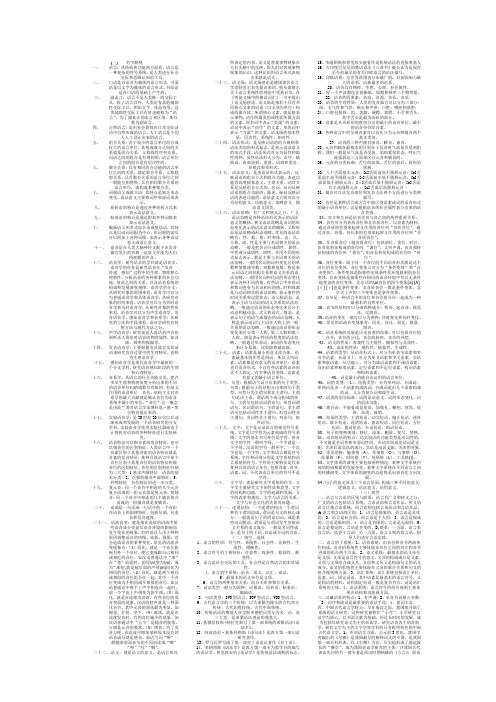
(一)名字解释一、语言:从结构和功能两方面看,语言是一种复杂的符号系统,是人类进行社会交际和思维认知的工具。
二、口语是以语音为载体的语言形式,书面语是以文字为载体的语言形式。
书面语是在口语的基础上产生的。
三、副语言:语言不是人类惟一的交际工具,除了语言以外,人类还有其他辅助性交际工具,例如文字、体态等等,这类辅助性交际工具有时也被称为“语言”,为了跟真正的语言相区别,所以称为副语言。
四、自然语言:是由社会群体在日常交际活动中自然形成的语言,人工语言是个别人人工设计出来的语言。
五、组合关系:若干较小的语言单位组合成较大的语言单位,其构成成分之间的关系就是组合关系,又称线性序列关系。
词语之间的组合是有规则的;语言单位之间的组合是有层次性的。
六、聚合关系:具有相同组合功能的语言单位之间的关系,就是聚合关系,又称联想关系。
具有聚合关系的语言单位之间一般能互相替换。
具有相同聚合关系的语言单位,就构成某种聚合类。
七、词根语又成孤立语,其特点是缺乏形态变化,语法意义主要靠词序和虚词来表示。
八、屈折语的特点是通过各种屈折方式来表示语法意义。
九、粘着语的特点是通过附加多种词缀来表示语法意义。
十、编插语又叫多式综合语或复综语,其特点是以动词词根为中心,在词根的前后可以附加上各种词缀,来表示各种语法意义或语汇意义。
十一、语音是在人类大脑神经支配下由发音器官发出的负载一定意义并能为人们所理解的声音。
十二、语音学:研究语音的学科就是语音学。
语音学的任务是研究语音在“发音---传递---感知”过程中的生理、物理和心理特性,分析语音的各种要素的社会功能,彼此之间的关系,以及语音系统的构成和发展演变规律。
语音学的分支:从研究对象的范围来看,语音学可以分为普通语音学和具体语音学;从研究对象的时间来看,语音学可以分为共时语音学和历时语音学;从研究对象的性质来看,语音学可以分为声学语音学、发音语音学、感知语音学和音系学;从研究的方法和手段来看,语音学研究有传统方法与现代方法之分。
语言学概论复习要点

语言学概论复习要点语言学概论复习提要一、语言学的对象和任务1.语言学的对象和任务(1)研究对象:语言。
(2)主要任务:研究语言的本质、结构和规律,使对语言的认识上升到理性阶段。
2.语言学简史(1)语文学阶段。
语言学三大发源地:古代中国、古代印度和古代希腊。
公元前4世纪,印度学者波尼尼的《梵语语法》或称《波尼尼语法》。
古希腊学者亚里士塔尔库斯的《希腊语法》。
早在公元前4世纪,被中国古代人们尊崇为十三经之一的《尔雅》就已初具规模,它是世界上第一部物类与义类的词典,比西方早了两千多年。
到东汉时期又出现了世界第一部字典《说文解字》,比西方的字典早了一千五、六百年。
古代中国的语文学通称小学,包括文字学、训诂学和音韵学,是中国古代语言学研究成就的集中体现。
语文学与现代语言学的区别:第一,从研究对象看,古代语言学只重视书面语言,把古代书面语作为语言的研究对象,而对当时社会普遍使用的口语不予重视。
第二,从研究任务看,古代语言学并不把描写语言的规律作为主要任务,只重视为流传下来的政治、哲学、宗教、历史、文学等方面的经典作注解,目的是为了让人们能够读通、读懂古代的经典。
换言之,它还没有发展成为一门独立的学科,而只是经学的附庸。
(2)历史比较语言学阶段。
19世纪初,西方语言学者开始运用历史比较法研究语言本身,产生了历史比较语言学。
在初创阶段,英国的威廉·琼斯最先发现希腊语和拉丁语、梵语有惊人的相似处,于是大胆地提出了“印欧语假设”,成为历史比较语言学的先驱。
德国的施列格尔也看到梵语和欧洲许多语言有着不可否认的共同点,第一个提出“比较语法”,是历史比较语言学的草创者。
历史比较语言学摆脱了过去从属经学的附庸地位,标志着语言学已经成为一门真正独立的学科。
历史比较语言学由于涉及多种语言,这为普通语言学的创立奠定了基础。
19世纪中叶,从理论上研究人类语言一般规律的普通语言学诞生。
奠基人是德国的洪堡特和瑞士的索绪尔。
洪堡特被公认为普通语言学的第一个奠基者,他的许多语言学观点被后代学者不断继承和发展。
语言学概论期末复习重点
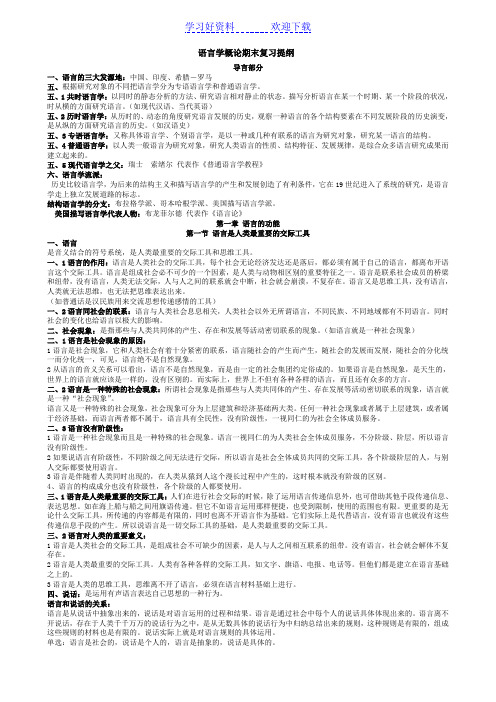
语言学概论期末复习提纲导言部分一、语言的三大发源地:中国、印度、希腊-罗马五、根据研究对象的不同把语言学分为专语语言学和普通语言学。
五、1共时语言学:以同时的静态分析的方法、研究语言相对静止的状态。
描写分析语言在某一个时期、某一个阶段的状况,时从横的方面研究语言。
(如现代汉语、当代英语)五、2历时语言学:从历时的、动态的角度研究语言发展的历史,观察一种语言的各个结构要素在不同发展阶段的历史演变,是从纵的方面研究语言的历史。
(如汉语史)五、3专语语言学:又称具体语言学、个别语言学,是以一种或几种有联系的语言为研究对象,研究某一语言的结构。
五、4普通语言学:以人类一般语言为研究对象,研究人类语言的性质、结构特征、发展规律,是综合众多语言研究成果而建立起来的。
五、5现代语言学之父:瑞士索绪尔代表作《普通语言学教程》六、语言学流派:历史比较语言学,为后来的结构主义和描写语言学的产生和发展创造了有利条件,它在19世纪进入了系统的研究,是语言学走上独立发展道路的标志。
结构语言学的分支:布拉格学派、哥本哈根学派、美国描写语言学派。
美国描写语言学代表人物:布龙菲尔德代表作《语言论》第一章语言的功能第一节语言是人类最重要的交际工具一、语言是音义结合的符号系统,是人类最重要的交际工具和思维工具。
一、1语言的作用:语言是人类社会的交际工具,每个社会无论经济发达还是落后,都必须有属于自己的语言,都离布开语言这个交际工具。
语言是组成社会必不可少的一个因素,是人类与动物相区别的重要特征之一。
语言是联系社会成员的桥梁和纽带,没有语言,人类无法交际,人与人之间的联系就会中断,社会就会崩溃,不复存在。
语言又是思维工具,没有语言,人类就无法思维,也无法把思维表达出来。
(如普通话是汉民族用来交流思想传递感情的工具)一、2语言同社会的联系:语言与人类社会息息相关,人类社会以外无所谓语言,不同民族、不同地域都有不同语言。
同时社会的变化也给语言以极大的影响。
胡壮麟语言学概论复习要点
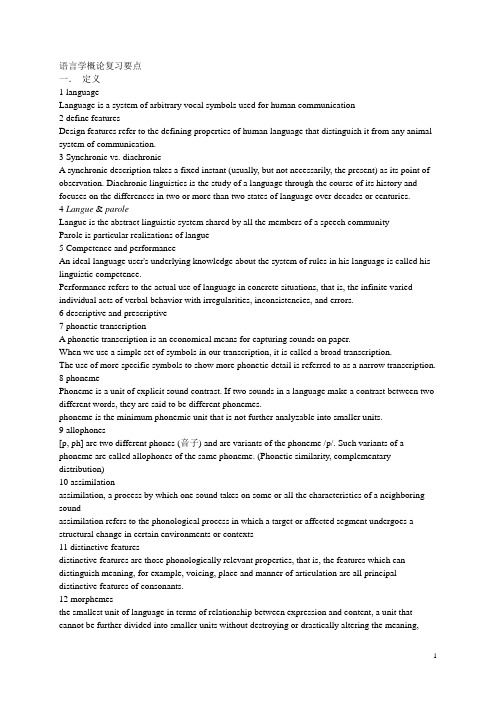
语言学概论复习要点一.定义1 languageLanguage is a system of arbitrary vocal symbols used for human communication2 define featuresDesign features refer to the defining properties of human language that distinguish it from any animal system of communication.3 Synchronic vs. diachronicA synchronic description takes a fixed instant (usually, but not necessarily, the present) as its point of observation. Diachronic linguistics is the study of a language through the course of its history and focuses on the differences in two or more than two states of language over decades or centuries.4 Langue & paroleLangue is the abstract linguistic system shared by all the members of a speech communityParole is particular realizations of langue5 Competence and performanceAn ideal language user's underlying knowledge about the system of rules in his language is called his linguistic competence.Performance refers to the actual use of language in concrete situations, that is, the infinite varied individual acts of verbal behavior with irregularities, inconsistencies, and errors.6 descriptive and prescriptive7 phonetic transcriptionA phonetic transcription is an economical means for capturing sounds on paper.When we use a simple set of symbols in our transcription, it is called a broad transcription.The use of more specific symbols to show more phonetic detail is referred to as a narrow transcription.8 phonemePhoneme is a unit of explicit sound contrast. If two sounds in a language make a contrast between two different words, they are said to be different phonemes.phoneme is the minimum phonemic unit that is not further analyzable into smaller units.9 allophones[p, ph] are two different phones (音子) and are variants of the phoneme /p/. Such variants of a phoneme are called allophones of the same phoneme. (Phonetic similarity, complementary distribution)10 assimilationassimilation, a process by which one sound takes on some or all the characteristics of a neighboring soundassimilation refers to the phonological process in which a target or affected segment undergoes a structural change in certain environments or contexts11 distinctive featuresdistinctive features are those phonologically relevant properties, that is, the features which can distinguish meaning, for example, voicing, place and manner of articulation are all principal distinctive features of consonants.12 morphemesthe smallest unit of language in terms of relationship between expression and content, a unit that cannot be further divided into smaller units without destroying or drastically altering the meaning,whether it is lexical or grammatical.(Free vs. Bound morphemes:Free morphemes: those that may constitute words by themselves, e.g. boy, girl, table, nation.; Bound morphemes: those that cannot occur alone, e.g. -s, -ed, dis-, un-Root vs. affix morphemes: a root morpheme can be a bound one or a free one. An affix morpheme can be a inflectional one or a derivational one.Inflectional vs. Derivative morphemes:Inflectional morpheme provides further grammatical meaning to the existing lexical item. Derivative morpheme provides lexical information to the existing lexical item)Root: A “root”is the base form of a word that cannot be further analyzed without total loss of identity. In other words, a “root”is that part of the word left when all the affixes are removed. Affix: “affix”is a collective term for the type of formative that can be used, only when added to another morpheme (the root or stem). Affixes are naturally bound and they are limited in number in a language.Stem(词干): A stem refers to the surplus part after the cutting of inflectional morpheme (曲折詞素)in a word.Base(词基): A base is any form to which affixes of any kind can be added; any root or stem can be termed a base13 positional relationPositional relation, or WORD ORDER, refers to the sequential arrangement of words in a language. syntagmatic, horizontal or chain relations.14 Relation of SubstitutabilityThe Relation of Substitutability refers to classes or sets of words substitutable for each other grammatically in sentences with the same structure.15Construction and ConstituentConstruction:the grammatical structure of a sentence or any smaller unit, represented by a set of elements and relations between them.(Endocentric construction is one whose distribution is functionally equivalent to that of one or more of its constituents, i.e., a word or a group of words, which serves as a definable centre or head. Exocentric construction refers to a group of syntactically related words where none of the words is functionally equivalent to the group as a whole, that is, there is no definable “Centre” or “Head” inside the group)A constituent is a word or a group of words that functions as a single unit within a hierarchical structure.IC analysis:the analysis of a sentence in terms of its immediate constituents-word groups or phrases, which are in turn analyzed into the immediate constituents of their own, and the process goes on until the ultimate constituents are reached.16 categoryThe term category refers to the defining properties of the general units of different word classes as well as their syntactic functions17 agreementAgreement (or concord) may be defined as the requirement that the forms of two or more words of specific word classes that stand in specific syntactic relationship should agree with one another in terms of some categories二.简答1 Design Features of Language:Arbitrariness Duality Creativity Displacement2 Functions of language❖referential (to convey message and information),❖poetic (to indulge in language for its own sake),❖emotive (to express attitudes, feelings and emotions),❖conative (to persuade and influence others through commands and requests),❖phatic (to establish communion with others)❖metalingual (to clear up intentions and meanings).-----JocobsonMetafunctions of Language❖ideational, interpersonal and textual functions.4 Functional Grammar⏹Theoretical approach to the description and explanation of linguistic phenomena based ontheir various functions.⏹basic assumption: linguistic phenomena cannot be explained without examining theirfunctionIt offers an alternative to (post) structuralism attempts at describing linguistic phenomena formally(i.e. assuming the autonomy of syntax)5 5.1 The Prague School⏹Prague Linguistic Circle:⏹Started by V. Mathesius (1882-1946) in 1926, with such activists as R. Jacobson(1896-1982), N. Trubetzkoy (1890-1938) and later J. Firbas (1921-2000).⏹The Circle stood at the heart of important developments in structural linguistics andsemiotics in the 1930's.⏹Three important points:⏹Stressed synchronic linguistics, but not rigidly separated from diachronic studies.⏹L is systemic in that no element of L can be satisfactorily analysed or evaluated inisolation and assessment can only be made if its relationship is established with thecoexisting elements in the same language system.⏹L is functional in that it is a tool for performing a number of essential functions ortasks for the community using it.5.1.1 Prague School Phonology⏹N. Trubetzkoy: Principle of Phonology (1939).⏹Phonetics & phonology: different for parole & langue.⏹Phoneme: an abstract unit of the sound system.⏹Distinctive features: phonological oppositions.⏹Showed distinctive functions of speech sounds and gave an accurate definition of thephoneme.Trubetzkoy’s contributions⏹Defined the sphere of phonological studies.⏹Revealed interdependent syntagmatic and paradigmatic relations between phonemes.⏹Put forward a set of methodologies for phonological studies.5.1.2 Functional Sentence Perspective⏹FSP is a theory about analysis of utterances (or texts) in terms of the information they contain.⏹Principle: the role of each utterance part is evaluated for its semantic contribution to thewhole.5.1.3 Communicative dynamism⏹J. Firbas⏹Linguistic communication is dynamic, not static.⏹CD measures the amount of info an element carries in a sentence. The degree of CD isthe effect contributed by a linguistic element. For example,5.2 The London School⏹ B. Malinowski (1884-1942), professor of anthropology (1927).⏹J. R. Firth (1890-1960), the first professor of linguistics in the UK (1944).⏹M. A. K. Halliday (1925- ), student of Firth.⏹All three stressed the importance of context of situation and the system aspect of L.5.2.1 Malinowski’s theories⏹Language “is to be regarded as a mode of action, rather than as a counterpart of thought”.⏹The meaning of an utterance comes from its relation to the situational context in which itoccurs.⏹Three types of situational context:⏹situations in which speech interrelates with bodily activity;⏹narrative situations;⏹situations in which speech is used to fill a speech vacuum—phatic communion.5.2.2 Firth’s theoriesa.语言观Regarded L as a social process, a means of social life.⏹L is a means of participation in social activities.⏹L is a means of doing things and of making others do things, a means of acting andliving.⏹L is both inborn and acquired.⏹The object of linguistic study is L in use.⏹The goal of linguistic inquiry is to analyse meaningful elements of L in order to establishcorresponding relations between linguistic and non-linguistic elements.⏹The method of linguistic study is to decide on the composite elements of L, explain theirrelations on various levels, and ultimately explicate the internal relations between theseelements and human activities in the environment of language use.b. 意义观Meaning is use. five parts of its analysis:⏹the relationship of each phoneme to its phonetic context;⏹the relationship of each lexical item to the others in the sentence;⏹the morphological relations of each word;⏹the sentence type of which the given sentence is an example;⏹the relationship of the sentence to its context of situation.In sum, he emphasizes three kinds of meaning: collocational meaning, referential meaning, and contextual meaningc. 语境观contextual analysis: situational context and linguistic context⏹Internal relations of the text:⏹syntagmatic relations in structure⏹paradigmatic relations in system⏹Internal relations of the context of situation:⏹relations between text and non-linguistic elements⏹analytical relations between elements of the text and elements within the situationd. Prosodic analysis (韵律分析): prosodic phonology⏹Since any human utterance is continuous speech flow made up of at least one syllable,it cannot be cut into independent units. Mere phonetic and phonological descriptionsare insufficient.⏹It is not phonemes that make up the paradigmatic relations, but Phonematic Units, thefeatures of which are fewer than those of phonemes and are called prosodic units.⏹prosodic units include such features as stress, length, nasalisation, palatalisation, andaspiration.⏹prosodic analysis is advantageous in categorising data and revealing the relations betweenthem compared with phonemic analysis一.论述1 TG grammarA brief introduction to generative grammar⏹Generative grammar: a system of rules that in some explicit and well-defined way assignsstructural descriptions to sentences. It aims to reveal the unity of particular grammars anduniversal grammars as well as human cognitive systems. To achieve this goal, a grammarshould achieve observational adequacy, descriptive adequacy and explanatory adequacy.⏹Different from Bloomfield’s data-oriented discovery procedure, he insists on theHypothesis-deduction method.Five stages of development⏹The Classical Theory⏹The Standard Theory⏹The Extended Standard Theory⏹The Revised Extended Standard Theory⏹The Minimalist Program4.1 Early theories (1957)4.1.1 Innateness hypothesis: the starting point of TG grammarLanguage is somewhat innate, and children are born with a Language Acquisition Device (LAD)—a unique kind of knowledge that fits them for language learning.Children are endowed with a universal knowledge of the basic grammatical relations and categories and study of language can shed light on the nature of the human mind.LAD consists of three parts: hypothesis maker, linguistic universal and evaluation procedure.⏹Evidences: children learn mother tongue very fast and with little effort; similar stagesexperienced by them (babbling stage, nonsense word stage, holophrastic stage, two-wordutterance, developing grammar, near-adult grammar, and full competence); learn the totalgrammar during limited period of time, from limited exposure to speech.⏹target: to reveal linguistic universals4.2 The classical theorySyntactic Structures (1957)⏹Three features: emphasis on generative ability of language, introduction of transformationalrules and grammatical description regardless of meaning.⏹finite state grammar, phrase structure grammar, and transformational grammar.4.2.1 Phrase structure grammar⏹ A system of finite rules generating an infinite number of sentences, and the rules are:generative, simple (represented by symbols and formulae), explicit (to state everythingprecisely), exhaustive (to cover all linguistic fact) and recursive (can be repeatedly applied to generate an infinite number of sentences)⏹more generative, stronger powerPhrase structural rules are also called rewritten rules, and the generative process of a sentence is that of rewriting one symbol into another.(NP(Det(the)N(man)) VP(V(hit)NP(Det(the)N(ball))))4.2.2 Transformational grammar⏹Linguistic competence : phrase structure grammar that consists rules governing idealizedsentence formation, and transformational grammar that enables us to manipulate sentences to produce the full range of sentence types.⏹Every sentence has a surface structure (a post-transformational stage) and a deep structure (apre-transformational stage)Deep structure and surface structure⏹Deep structure: the abstract structure and the propositional core. The underlying structure thatspecifies the grammatical relations and functions of the syntactic elements as well as themeaning of constituents.⏹Surface structure: the actually produced structure and the directly observable actual form. Anabstract sentence structure resulting from the application of transformational rules. Transformation⏹the relationship between deep structure and surface structure.⏹responsible for the generation of many phrase markers not generated directly by the phrasestructure rules, and thus contribute to the open-endedness and creativity of languages.⏹structural analysis (SA) and structural change (SC)⏹SA shows which relevant structural properties phrase markers must have for thetransformations to apply and specifies the input. (structural description SD)⏹SC describes the effect of the transformation and specifies what the output structure will be.⏹Transformation is based on the deletion and insertion of constituents. Substitution andpermutation are derived from them.4.3 The standard theory (1965)⏹Aspects of the Theory of Syntax (1965)⏹three components: syntactic (base component including categories and lexicon, andtransformational components), semantic (makes semantic interpretations on the deepstructure), phonological (phonological interpretation on the surface structure).⏹Category component is somewhat similar to the re-writing rules, but with featurespecifications for the words.⏹N ◊ [+N, ±Common]⏹[+Common] ◊ [±Count]⏹[+Count] ◊ [±Animate]⏹[-Common] ◊ [±Animate]⏹[+Animate] ◊ [±Human]⏹[-Count] ◊ [±Abstract]⏹verbs are subcategoriezed according to the context they occur in. eat [+V,+--NP, +--#]⏹words with the same feature specifications are in a paradigmatic relation and can occur in thesame specific context. Sincerity may frighten the boy.⏹transformations can’t alter the meaning⏹selection restriction⏹restrictions on transformations⏹the symbol S is introduced, which means that a sentence can be embedded⏹order of the rules4.4 The Extended Standard Theory⏹the first revision of the Standard Theory (the EST): the principle that the transformation rulecan’t change meaning cannot be held with the passive transformation. E.g. I have been taught physics by Einstein. Surface structure also has some bearing on semantic interpretation.⏹The second revision (the REST): all the necessary information for semantic interpretation canbe captured by the surface structure with the help of the notion trace.Beavers built damsDams are built t by beavers4.5 the Theory of Government and Binding⏹In 1981, Lectures on Government and Binding⏹ A Rule system with four components: lexicon, syntax (categorical component andtransformational component), phonetic form and logical form. The transformationalcomponent has one rule: move α: any element may be moved to another place, or moregenerally changed in some way, as long as the relevant conditions are satisfied.⏹ A principle system which specifies these conditions: bound theory, θtheory, bindingtheory, government theory, case theory and control theory, among which we only focus ongovernment and binding theory here.The minimalist program:⏹ a universal grammar is a theory for studying the initial states and particular grammars studythe states of acquisition.Particular language exposureUniversal Grammar Particular Grammar4.5 Main features of TG Grammar⏹The development of TG reflects a process of constantly minimalising theories and controllingthe generative powers.⏹rationalism, innateness, deductive methodology, emphasis on interpretation, formalization,emphasis on linguistic competence, strong generative powers, emphasis on linguisticuniversals.Systemic-functional grammar⏹Two components and inseparable parts:⏹systemic grammar: internal relations in L as a system network, meaning potential.⏹functional grammar: L as a means of social interaction, uses or functions of languageform.5.2.3.1Systemic grammar⏹System: a set of mutually exclusive options that can appear in a linguistic structure.⏹characteristics (entry conditions): options have a common area of meaning and grammaticalenvironment; mutually exclusive; finite; interdependent relationships between terms ofdifferent systems.⏹Delicacy is a scale on which we can arrange systems according to the fineness of thedistinction.⏹ A system is simultaneous with another if they are independent of each other but have the sameentry conditions. Their terms can combine freely to enable us to make more delicatedistinctions in meaning.⏹SG: a chart of the full set of choices available in constructing a sentence, with a specificationof the relationships between choices.⏹realization relationships between various levels: semantics (meaning)lexicogrammar (form)phonology(substance)⏹features of SG:a. emphasizes the sociological aspectsb. L is a form of doing rather than knowingc. distinguishes linguistic behavior potential from actual linguistic behaviord. emphasizes particular languagee. explains L in terms of clines (continuum)f. empirical: observation from texts and by means of statistical techniquesg. The category of the system is the core.5.2.3.2 Functional grammar⏹Ideational function (experiential & logical): to convey new info, communicate a contentunknown to the hearer⏹Interpersonal function: to express social and personal relations⏹Textual function: to make any stretch of spoken or written discourse into a coherent andunified text and make a living passage different from a random list of sentences.Ideational functionExperiential function: six processes of transitivity⏹ A process, in principle, mainly consists of three components:(1)the process itself(2)participants in the process;(3)circumstances associated with the process.⏹L can express experiential function by building a mental picture of reality to interpret or makesense of what goes on around us or inside us..a Material process: process of doing⏹Actor—the one who does something⏹Goal—the one who receives the action⏹Dispositive type: the lion caught the tourist.⏹Creative type: they wrote a letter.Transitivity analysis of John built a house.Actor: JohnProcess: Material: Creation: builtGoal: Affected: a new houseb.Mental process: process of sensing⏹The human conscious participant is called the Senser and the other one called Phenomenon.The three sub-processes of the mental process: feeling, perceiving and thinking are labeled in more general terms: 1. PERCEPTION (seeing, hearing, smelling), 2. AFFECTION (liking,fearing, etc. ) and 3. COGNITION (thinking, knowing, understanding).⏹John likes the house.Senser :JohnProcess: mental: affection: likesPhenomenon: the housec. Relational process: process of being⏹two parts are related in a certain way, indicated by verbs like be, become, turn, etc.d. Behavioral Processes⏹processes of physiological and psychological behaviors, like smiling, breathing, coughing, etc.⏹The participant: one participant called Behaver, typically a conscious beinge. Verbal process: a process of saying⏹Apart from the Sayer, there are other three participants in a verbal process: (1) RECEIVER,(2)VERBIAGE, (3) TARGET. The first two are oblique participants, that is, they are in theoblique case (间接格).⏹The RECEIVER is the participant to which the saying is directed.He didn’t tell me the truth.f. Existential Process⏹It represents that something exists or happens. The thing that exists is labeled Existent Interpersonal function⏹embodies all uses of language to express social and personal relations.⏹realized by mood and modality.Mood⏹the role selected by the speaker in the speech situation an that he assigns to the addressee. Two speech roles: giving and demanding.Contents of giving/demanding: goods-services/information⏹In sum, we have four moods: offer, command, statement and question P.314⏹Mood includes two parts: subject and finite.⏹Subject : N, NP or clause⏹Finite elements: Aux and M to express tense or modality, one part of VP.⏹ResidueTextual function⏹to make any stretch of spoken or written discourse into a coherent and unified text rather thana random list of sentences.⏹related to the theme-rheme structure⏹two inseparable components for an integral framework of Systemic-Functional linguisticstheory.⏹SG aims to explain the internal relations in L as a system of meaning potential. FG functionsto reveal that L is a means of interaction. SG has a functional component, and the theorybehind his FG is systemic.⏹innovation: relate his FG to its structure. The three metafunctions are related respectively tothree systems: transitivity, mood and theme.A brief summary: formalism vs. functionalism⏹Formalism: Structural grammar & TG grammar which pays more attention to structures.⏹Functionalism: functional grammar which emphasizes systems and relates them to functionsplayed by L.Semantics1 The conceptualist (referential) theory●The conceptualist theory treats meaning as concept or reference to cope with problems of thenaming theory.●any particular sound image is psychologically associated with a particular concept.2 Types of meaningLeech’s seven types of meaningGeoffrey Leech (1974, 1981). Semantics: The Study of Meaning.●Conceptual meaning●Associative●Connotative meaning●Social meaning●Affective meaning●Reflected and meaning●Collocative meaning●Thematic meaning3 marked and unmarkedUnmarked forms: more usual, easy to learn, broader in meaning, non-metaphoricalMarked forms: less frequently used.4 Antonymya: gradable antonymy (semantic polarity and semantic relativity; continuum; markedness)good ----------------------- bad●Can be modified by adverbs of degree like very. Can have comparative forms. Can beasked with how.●graded against different norms●one member of a pair, usually the one for the higher degree, serves as the cover term orunmarked term. E.g. How long…, lengthb: Complementary antonymy. These antonyms divide a semantic field completely. The assertion of one means the denial of the other and there is no intermediate ground between the two. A yes or no question, not a choice between more or less.●alive : dead male : femaleFeatures: no comparative or superlative degrees. absolute norm, no cover termc: converse antonymy (关系反义词): the two members of the pair do not constitute a positive-negative opposition. They show the reversal of a relationship between two entities in reciprocal social roles. X presuppose Y.buy : sell lend : borrow husband : wife smaller: bigger反义词有不稳定性,针对具体语义特征而言。
语言学概论复习资料

第一章语言和语言学第一节认识人类的语言一、语言的性质和类型1.只有人类才有语言【领会】语言是人类所独有的。
人类的语言跟动物的“语言”相比较,有几个显著和重要的特点:一是“内容更多”。
多种场合、多种方式、多种内容。
二是“用处更大”。
主要:交际功能。
其它:标志、记录、思维、认知,等等。
三是“能够创造”。
具有离散性,能用有限的声音和意义按照一定规则组配成无限的话语。
2.语言和民族、国家的关系【领会】大多数情况:一个民族使用一种语言。
但不能把“相互能够听懂”作为确定语言的标准,并进一步作为确定民族和国家的标准。
这种理解只适合于欧洲的“新兴民族国家”,对一个历史悠久、幅员辽阔的国家是不适应的。
尽管“语言”是最直观、最容易识别的民族标志,但事实上还不是最可靠的标志。
从目前了解到的情况来看,“共同的历史文化传统和由此产生的民族认同感”也许是维系一个民族的最根本的因素,因而也是确定一个民族的最根本的标准。
3.语言的谱系分类和语言的形态分类【领会】语言的谱系分类就是从“历时”演变角度划分不同的语言,是根据各种语言在语音、语汇、语法等方面是否有共同来源和相似性的大小对语言进行的分类。
也叫“语言的亲属关系分类”。
从语言的“共时”角度来划分不同的语言,可以建立“语言的形态分类”,也叫“语言的结构类型分类”。
可分为“形态语”和“孤立语”,或者分成“综合性语言”和“分析性语言”。
4.语系、语族;屈折语、孤立语;综合性语言、分析性语言【识记】谱系分类层级:语系、语族、(语支)、语言、方言、次方言(土语)。
语系是根据语言有无历史同源关系划分出来的语言类别,是语言谱系中最大的类。
语系的下一级叫作“语族”,同一语族的语言不但有相同的来源,相似点也更多。
形态语(综合性语言)指通过词的形态变化来体现各种结构意义的语言。
包括“屈折语、黏着语”等小类。
如俄语、维吾尔语。
孤立语(分析性语言)指没有形态变化的语言。
如汉语。
屈折语主要是句子中某些词本身有丰富的形态变化,是形态语中的一个小类。
汉语言文学语言学概论复习要点

《语言学概论》复习要点重点名词概念:语言学、普通语言学、专语语言学、共时语言学、历时语言学一、语言学、语言学的对象和任务二、语言学在科学体系中的地位三、语言学的基本类别根据研究的对象的不同,语言学分为共时语言学和历时语言学、专语语言学和普通语言学。
四、语言学流派各个语言学流派的观点、代表人物有所了解即可,注意布拉格学派、哥本哈根学派以与美国结构语言学派(也称美国描写语言学)都属于结构主义学派,是这一学派的三个分支。
关于语言学流派的具体内容阐述,不作考试要求。
第一章言语的社会功能本章须明确两个大的要点:语言的社会功能,即交际工具和思维工具;语言是一种社会现象。
主要名词概念:语言、社会、社会现象第一节语言是人类最重要的交际工具一、语言是人类社会的交际工具1.语言的交际功能:语言是人类区别于其它动物的一个重要标志。
语言是联系社会成员的桥梁和纽带,是社会成员互相之间交际和交流思想的工具,也是协调社会成员行动一致的工具。
2.语言是一种社会现象:语言是一种社会现象,和人类社会有着十分紧密的联系,没有人类社会,就没有语言,人类社会以外的社会无所谓语言。
所谓社会现象是指那些与人类共同体的产生、存在和发展等活动密切联系的现象。
不同的民族有不同的语言,不同的地域有不同的语言,同时社会的变化也给语言以极大的影响,而离开了人类社会,就无所谓语言可言了。
总之,语言就是一种社会现象,同社会的关系非常密切,其产生、发展等都要受到社会的影响。
语言不是自然现象,一方面,语言同社会有着十分紧密的联系,社会的发展变化直接影响着语言的发展变化,也就是说,语言的发展变化是受制于社会的;另一方面,从语言的音义联系看语言不是自然现象,而是社会约定俗成的,没有必然的本质的联系,如果语言是自然现象,世界上的语言应该一样的,没有区别的,而实际上世界上的语言多种多样,而且许多语言中还有方言,这说明语言决不是自然现象。
3.语言是一种特殊的社会现象:语言不但是社会现象,而且是一种特殊的社会现象。
语言学概论复习(完整)
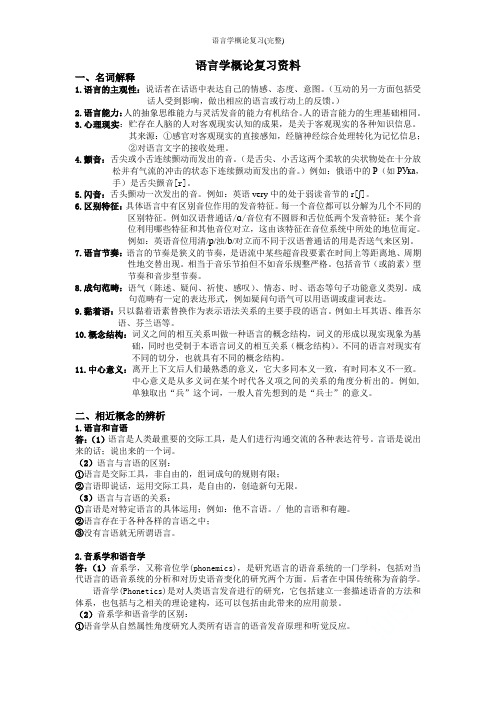
语言学概论复习资料一、名词解释1.语言的主观性:说话者在话语中表达自己的情感、态度、意图。
(互动的另一方面包括受话人受到影响,做出相应的语言或行动上的反馈。
)2.语言能力:人的抽象思维能力与灵活发音的能力有机结合。
人的语言能力的生理基础相同。
3.心理现实:贮存在人脑的人对客观现实认知的成果,是关于客观现实的各种知识信息。
其来源:①感官对客观现实的直接感知,经脑神经综合处理转化为记忆信息;②对语言文字的接收处理。
4.颤音:舌尖或小舌连续颤动而发出的音。
(是舌尖、小舌这两个柔软的尖状物处在十分放松并有气流的冲击的状态下连续颤动而发出的音。
)例如:俄语中的Р(如РУка,手)是舌尖颤音[r]。
5.闪音:舌头颤动一次发出的音。
例如:英语very中的处于弱读音节的r[ʃ]。
6.区别特征:具体语言中有区别音位作用的发音特征。
每一个音位都可以分解为几个不同的区别特征。
例如汉语普通话/ɑ/音位有不圆唇和舌位低两个发音特征;某个音位利用哪些特征和其他音位对立,这由该特征在音位系统中所处的地位而定。
例如:英语音位用清/p/浊/b/对立而不同于汉语普通话的用是否送气来区别。
7.语言节奏:语言的节奏是狭义的节奏,是语流中某些超音段要素在时间上等距离地、周期性地交替出现。
相当于音乐节拍但不如音乐规整严格。
包括音节(或韵素)型节奏和音步型节奏。
8.成句范畴:语气(陈述、疑问、祈使、感叹)、情态、时、语态等句子功能意义类别。
成句范畴有一定的表达形式,例如疑问句语气可以用语调或虚词表达。
9.黏着语:只以黏着语素替换作为表示语法关系的主要手段的语言。
例如土耳其语、维吾尔语、芬兰语等。
10.概念结构:词义之间的相互关系叫做一种语言的概念结构,词义的形成以现实现象为基础,同时也受制于本语言词义的相互关系(概念结构)。
不同的语言对现实有不同的切分,也就具有不同的概念结构。
11.中心意义:离开上下文后人们最熟悉的意义,它大多同本义一致,有时同本义不一致。
语言学概论复习要点

语言学概论复习要点《语言学概论》复习要点导言重点名词概念:语言学、普通语言学、专语语言学、共时语言学、历时语言学一、语言学、语言学的对象和任务二、语言学在科学体系中的地位三、语言学的基本类别根据研究的对象的不同,语言学分为共时语言学和历时语言学、专语语言学和普通语言学。
四、语言学流派各个语言学流派的观点、代表人物有所了解即可,注意布拉格学派、哥本哈根学派以及美国结构语言学派(也称美国描写语言学)都属于结构主义学派,是这一学派的三个分支。
关于语言学流派的具体内容阐述,不作考试要求。
第一章言语的社会功能本章须明确两个大的要点:语言的社会功能,即交际工具和思维工具;语言是一种社会现象。
主要名词概念:语言、社会、社会现象第一节语言是人类最重要的交际工具一、语言是人类社会的交际工具1.语言的交际功能:语言是人类区别于其它动物的一个重要标志。
语言是联系社会成员的桥梁和纽带,是社会成员互相之间交际和交流思想的工具,也是协调社会成员行动一致的工具。
2.语言是一种社会现象:语言是一种社会现象,和人类社会有着十分紧密的联系,没有人类社会,就没有语言,人类社会以外的社会无所谓语言。
所谓社会现象是指那些与人类共同体的产生、存在和发展等活动密切联系的现象。
不同的民族有不同的语言,不同的地域有不同的语言,同时社会的变化也给语言以极大的影响,而离开了人类社会,就无所谓语言可言了。
总之,语言就是一种社会现象,同社会的关系非常密切,其产生、发展等都要受到社会的影响。
语言不是自然现象,一方面,语言同社会有着十分紧密的联系,社会的发展变化直接影响着语言的发展变化,也就是说,语言的发展变化是受制于社会的;另一方面,从语言的音义联系看语言不是自然现象,而是社会约定俗成的,没有必然的本质的联系,如果语言是自然现象,世界上的语言应该一样的,没有区别的,而实际上世界上的语言多种多样,而且许多语言中还有方言,这说明语言决不是自然现象。
3.语言是一种特殊的社会现象:语言不但是社会现象,而且是一种特殊的社会现象。
语言学概论复习提纲及要点
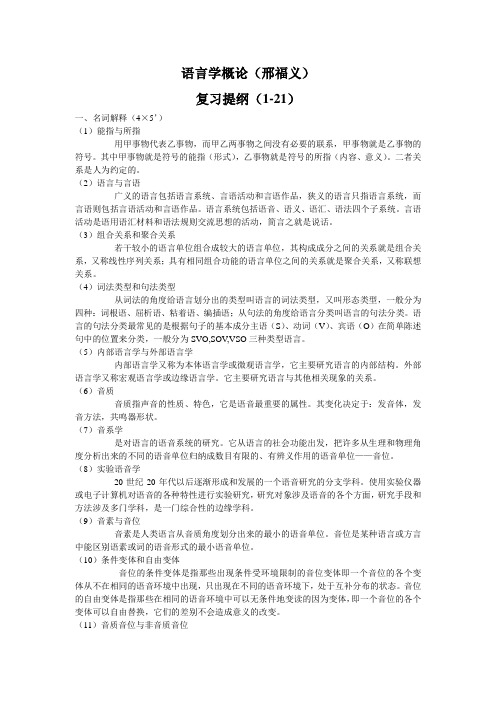
语言学概论(邢福义)复习提纲(1-21)一、名词解释(4×5’)(1)能指与所指用甲事物代表乙事物,而甲乙两事物之间没有必要的联系,甲事物就是乙事物的符号。
其中甲事物就是符号的能指(形式),乙事物就是符号的所指(内容、意义)。
二者关系是人为约定的。
(2)语言与言语广义的语言包括语言系统、言语活动和言语作品,狭义的语言只指语言系统,而言语则包括言语活动和言语作品。
语言系统包括语音、语义、语汇、语法四个子系统。
言语活动是语用语汇材料和语法规则交流思想的活动,简言之就是说话。
(3)组合关系和聚合关系若干较小的语言单位组合成较大的语言单位,其构成成分之间的关系就是组合关系,又称线性序列关系;具有相同组合功能的语言单位之间的关系就是聚合关系,又称联想关系。
(4)词法类型和句法类型从词法的角度给语言划分出的类型叫语言的词法类型,又叫形态类型,一般分为四种:词根语、屈析语、粘着语、编插语;从句法的角度给语言分类叫语言的句法分类。
语言的句法分类最常见的是根据句子的基本成分主语(S)、动词(V)、宾语(O)在简单陈述句中的位置来分类,一般分为SVO,SOV,VSO三种类型语言。
(5)内部语言学与外部语言学内部语言学又称为本体语言学或微观语言学,它主要研究语言的内部结构。
外部语言学又称宏观语言学或边缘语言学。
它主要研究语言与其他相关现象的关系。
(6)音质音质指声音的性质、特色,它是语音最重要的属性。
其变化决定于:发音体,发音方法,共鸣器形状。
(7)音系学是对语言的语音系统的研究。
它从语言的社会功能出发,把许多从生理和物理角度分析出来的不同的语音单位归纳成数目有限的、有辨义作用的语音单位——音位。
(8)实验语音学20世纪20年代以后逐渐形成和发展的一个语音研究的分支学科。
使用实验仪器或电子计算机对语音的各种特性进行实验研究,研究对象涉及语音的各个方面,研究手段和方法涉及多门学科,是一门综合性的边缘学科。
(9)音素与音位音素是人类语言从音质角度划分出来的最小的语音单位。
语言学概要复习重点
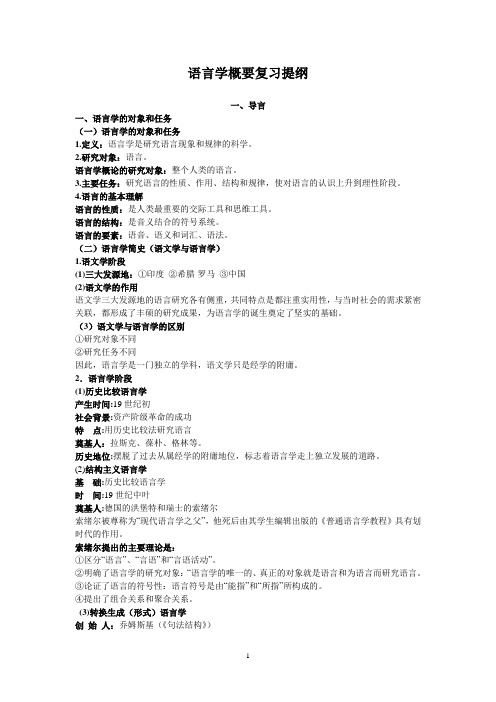
语言学概要复习提纲一、导言一、语言学的对象和任务(一)语言学的对象和任务1.定义:语言学是研究语言现象和规律的科学。
2.研究对象:语言。
语言学概论的研究对象:整个人类的语言。
3.主要任务:研究语言的性质、作用、结构和规律,使对语言的认识上升到理性阶段。
4.语言的基本理解语言的性质:是人类最重要的交际工具和思维工具。
语言的结构:是音义结合的符号系统。
语言的要素:语音、语义和词汇、语法。
(二)语言学简史(语文学与语言学)1.语文学阶段(1)三大发源地:①印度②希腊-罗马③中国(2)语文学的作用语文学三大发源地的语言研究各有侧重,共同特点是都注重实用性,与当时社会的需求紧密关联,都形成了丰硕的研究成果,为语言学的诞生奠定了坚实的基础。
(3)语文学与语言学的区别①研究对象不同②研究任务不同因此,语言学是一门独立的学科,语文学只是经学的附庸。
2.语言学阶段(1)历史比较语言学产生时间:19世纪初社会背景:资产阶级革命的成功特点:用历史比较法研究语言奠基人:拉斯克、葆朴、格林等。
历史地位:摆脱了过去从属经学的附庸地位,标志着语言学走上独立发展的道路。
(2)结构主义语言学基础:历史比较语言学时间:19世纪中叶奠基人:德国的洪堡特和瑞士的索绪尔索绪尔被尊称为“现代语言学之父”,他死后由其学生编辑出版的《普通语言学教程》具有划时代的作用。
索绪尔提出的主要理论是:①区分“语言”、“言语”和“言语活动”。
②明确了语言学的研究对象:“语言学的唯一的、真正的对象就是语言和为语言而研究语言。
③论证了语言的符号性:语言符号是由“能指”和“所指”所构成的。
④提出了组合关系和聚合关系。
(3)转换生成(形式)语言学创始人:乔姆斯基(《句法结构》)主要观点:认为语言描写和分析的目的不在于分类,而在于建立一种理论,在于研究人的语言生成能力,即怎样用有限的成分和规则生成无限的句子。
理论构成:主要包括生成规则和转换规则两部分。
①生成规则包括一套短语结构规则和词汇插入规则。
语言学概论复习资料(全)

语言学概论复习资料(全)语言学概论复习资料(全)语言学概论一、知识题(填空与选择):1、语言的客观存在形式,首先表现为人与人之间的口头交际行为。
2、口语是第一性的,书面语是第二性的。
3、瑞典、挪威、丹麦三个国家使用同一个语言。
4、口语和书面语包括物理现象和心理现象。
5、口头交际活动有两个因素:语言和言语。
6、瑞士语言学家索绪尔的《普通语言学教程》开创了20世纪现代语言学的新局面。
7、语言系统是由语音系统、语汇系统、语法系统、语义系统组成。
8、在任何语言中,音调变化都是语调的主要构成因素。
9、音强变化在许多语言中有区别意义的作用。
10、音质是由声波的形式决定的。
11、音质是声音四要素中最重要的。
12、人体的发音器官包括发音的动力源、发音体、共鸣腔。
13、口腔、鼻腔和咽腔是人类共鸣腔。
14、语音的物理属性和生理属性是语音的自然属性。
15、[e][ ε][a][ u ][o ][ ][ ɑ]八个音被称作定位元音或标准元音。
16、辅音的音质决定于发音部位和发音方法。
17、音位变体分条件变体和自由变体。
18、音素之间存在着对立关系和互补关系。
19、韵母分成韵头、韵腹、韵尾。
20、常见的语流音变现象有同化、异化、脱落、弱化、增音。
21、同化又可分顺同化和逆同化。
22、从音位理论的角度看,最小的音段是音位。
音位的组合又可进一步划分为音节、音节组合、语句。
23、汉藏语系包括汉语、藏语、苗语。
印欧语系一般都是非声调语言,包括英语、法语、俄语等。
24、声调可从调值和调位两方面来分析。
25、重音可分为词重音和句重音。
26、语汇学包括语汇的类聚系统和语汇的构造形式。
27、根据音节的数量将词分成单音节词、双音节词和多音节词。
根据包含语素的数量将词分成单纯词和合成词。
28、古语词包括历史词语和文言词语。
根据词的不同来源分成新造词、古语词、方言词和外来词。
29、语法分为词法部分和句法部分。
30、语法单位通常分成语素、词、词组和句子。
(完整word版)语言学概论总复习

语言学概论总复习绪论部分小学普通语言学具体语言学语言学史中的重要代表人物及作品语言学的三大发源地人类传递信息的五个过程第一章语言的功能1.语言的功能。
2.语言和思维的关系3.思维能力是全人类相同的,语言是各民族不同的。
第二章语言符号任意性线条性二层性组合关系聚合关系1.为什么说语言是一种符号系统?2.秦赵高指鹿为马,但结果鹿还是鹿,马还是马,这是为什么?用语言符号的理论回答3.同样表示“父亲”“母亲”,汉语用“baba mama”,英语用father mother,为什么会有这样的差别?4.什么是语言的结构二层性?用汉语为例加以说明5.说话只能在有限和无限、自由和不自由的矛盾中进行。
6.语言符号的系统性表现在哪些方面?7.人类语言和动物“语言”的本质区别是什么?第三章语音音素音位音位变体自由变体条件变体音质音位非音质音位音位的区别特征语流音变音节1.语音四要素以及之间的关系。
2.请举例说明语音的社会属性。
3.元音和辅音的区别4.元音的音质由哪些方面的音素决定的?举例说明5.元音舌位图的设计原理?6.怎样认识音位和音素的关系?7.举例说明区分、归并音位的原则。
8.怎样认识音位和音位变体的关系?9.音位的系统性表现在哪些方面?请以普通话为例说明.10. 语流音变有哪些具体表现?请结合具体例子理解。
11.举例说明汉语音节结构的特点。
12.按普通话读音给“他天天在书房里画画儿”注上国际音标。
这句话里有几个元音音位?13.判断下列说法的正误,并说明理由。
英语/P/音位和汉语普通话/P/音位不是对等的.第四章一、语法单位;词;语素;单纯词;合成词;词缀;词根;派生词缀;屈折词缀;词类;语法形式;语法意义;形态;语法范畴;语法的递归性;变换分析;屈折语;孤立语;黏着语二、变换下列句子,使其具有句法同义:1. 我打破了杯子;2. 我们找到了小王三、用变换分析法区分句法多义1.关心的是他母亲。
2.虚构的故事吓坏人。
语言学概论复习要点-

语言学概论复习要点一、期末复习要注意的几个问题复习语言学概论课程,总的要求是:弄清楚基本概念的准确含义,抓住重点,全面复习。
复习的总要求可以从以下几个方面来理解:第一,吃透内容要点复习不但要掌握比较重大的要点,弄清楚各个章节的框架结构,对各个重点内容的要点也要非常熟悉,每个要点要求都能展开阐述,比如基本词汇的特点,什么是全民常用,什么是稳固,什么是有构词能力,这些特点相互之间是怎样影响的,都必须能结合实例说出个所以然来。
如果复习不全面不细致,理解问题不深入透彻,遇到这样的问题恐怕就只能是干巴巴的条款了,那样是很难取得优异成绩的,也不符合本课程掌握基础知识、基本概念、基本理论的“三基”的要求。
第二,掌握常用的名词概念专门就名词概念提出复习要求,这是因为两个方面的原因:一方面,名词概念是一门学科体系的重要组成部分,是学科知识的基础部分,学科体系在很大程度上是通过一系列的名词概念串连起来的。
另一方面,期末试题名词解释题目还是一个考核重点,而且还占有非常重的分量。
我们在中央电大编辑部发行的《语言学概论期末复习指导》中列出了一些重点名词,复习可参考这部分内容。
第三,弄清基本理论知识并能灵活地加以运用。
本课程是一门理论性很强的课程,因此,复习首先要注意把基本理论吃透。
所谓吃透,就是能理解其内容,能灵活运用理论来分析问题,而不是死记硬背。
例如音位的分析原则、各种变体、语素的分类、词和词组句子的分析等等,都是如此,都要求既掌握理论,又能灵活运用。
比如词组的结构层次分析,可以说是必考的内容,但如果只机械死记主谓、述宾、述补、偏正、联合结构这些概念,是没有意义的,必须弄懂其内涵,再结合具体的的词组灵活自如地进行分析辨认。
二、期末试题情况介绍(一)试题编制所遵循的原则第一,以教学大纲规定的内容为出题的范围依据;第二,以考核说明规定的考核层次要求和题型为依据;考核说明有关知识点的层级规定,需要琢磨;第三,以考查学科的基本知识为主,同时考核学生对基本知识理论的理解和运用能力。
(完整word)岑运强主编的语言学概论期末资料复习,重点

总论:一、语言学的性质和任务专门研究人类语言的学科叫做语言学。
语言学是高校中文系必修的专业基础课。
大学中文系的语言学课程包括古代汉语、现代汉语和语言学概论等.古代汉语课程主要研究中国古代的语言,包括上古、中古、近代等若干阶段;现代汉语课程主要研究五四以来的语言;语言学概论不但涉及以上两门课程内容,还涉及大量外语知识,具有明显的交叉性,着重从理论上去研究语言.它着重在理论上对人类语言的共同规律进行研究,而这种研究又必须建立在个别的、实际的语言研究的基础上。
索绪尔对语言学的分类:1、语言的语言学和言语的语言学.2、历时语言学(研究语言历史)和共时语言学(研究语言现状)3、微观(内部)语言学和宏观(外部)语言学五段两线解放1、五段:(1)语文学阶段:研究古文献和书面语的学问。
目的让人读懂古文献,而不在于研究语言。
使得语言研究成为其他学科的附庸,还没有成为一门独立的科学.(2)历史比较语言学阶段19世纪初,英国人威廉·琼斯提出“印欧语假设”,成为历史比较语言学的先驱。
德国学者施列格尔提出“比较语法”,是历史比较语言学的草创者。
这以后,一大批学者建立了一套科学的历史比较方法,找出了不同语言的亲属关系,产生了历史比较语言学。
从而把语言研究从哲学、逻辑学等学科的附庸地位中解放出来,标志语言学已经成为一门真正独立学科。
19世纪中期,从理论上研究语言一般规律的普通语言学诞生。
奠基人先后分别是德国人洪堡特与瑞士人索绪尔。
(3)结构主义语言学阶段结构主义鼻祖——索绪尔结构主义语言学派又分为三派:布拉格学派(功能派)、哥本哈根学派(符号派)、美国派(描写派,影响最大)掌握每个学派2名代表人物。
结构主义语言学派推崇直接成分分析法(层次分析法)。
结构主义语言学派对中国的语言研究产生过巨大的影响。
(4)形式语言学阶段美国转换生成语法创始人-—乔姆斯基,目标是一个能生成所有句子的语法系统,主要包括生成和转换两个方面。
语言学概论复习资料

语言的性质:语言具有符号性(任意性、稳固性、渐变性、线条型)、系统性、社会性、民族性、生成性、模糊性。
语言与言语:语言:广义的语言包括语言系统、言语活动和言语作品,狭义的语言只指语言系统。
言语则包括言语活动和言语作品。
语言与言语的区别:语言是抽象的、社会的、现成的、有限的、稳定的,言语是具体的、个人的、临时的、有限的、多变的。
语言与言语的联系:语言来自于言语,依存于言语;语言又制约着言语指导人们进行言语实践。
语言的包括口语与书面语两种表现形式。
口语是以语音为载体的语言形式,书面语是以文字为载体的语言形式。
书面语是在口语的基础上产生的,即口语是第一性,书面语是第二性。
口语比较灵活易变,而书面语比较保守稳固。
自然语言与人工语言:自然语言是由社会群体在日常交际活动中自然形成的语言,如汉语英语等。
人工语言是个别人人工设计出来的语言。
自然语言与人工语言除了社会性与个人性、自然性与人工性的区别外,自然语言具有民族性,人工语言具有国际性。
自然语言充满模糊性、多义性,人工语言一般比较明确没有歧义。
自然语言由全体社会成员使用,人工语言一般限于特定的范围使用。
自然语言可以作为母语自然学会,人工语言则不可以,自然语言有丰富的变体。
世界语就是一种典型的人工语言,在19世纪末由波兰医生柴门霍夫提出,世界语以印欧语系的语言为基础。
语言结构:语言系统可以划分为语音、语义、语汇语法是个子系统。
语言系统的符号与符号之间的复杂关系可以高度概括为组合关系与聚合关系两种基本关系。
语言的层级:语言层级系统的下层是语言符号的形式层,即语音层。
语音层包括音位和音节两个级别的语音单位。
音位的上一级语音单位是音节,一个音节由一个或几个音位构成。
音节是人们能自然感知的最小语音单位。
语言层级系统的上层是语音和语义结合的符号和符号组合层,上层包括三个级别的基本语言单位:语素、词、句子。
语言层级的特点:1、从语言的下层到上层有一个质的变化;2、从下一级语言单位到上一级都有量的扩充。
语言学概论复习资料
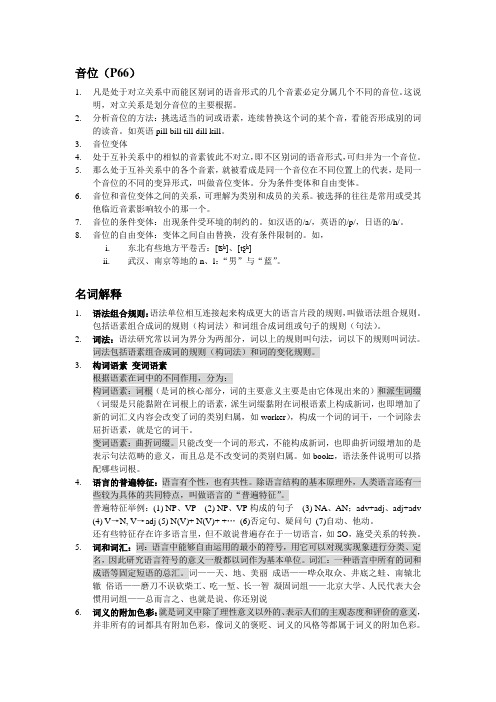
音位(P66)1.凡是处于对立关系中而能区别词的语音形式的几个音素必定分属几个不同的音位。
这说明,对立关系是划分音位的主要根据。
2.分析音位的方法:挑选适当的词或语素,连续替换这个词的某个音,看能否形成别的词的读音。
如英语pill bill till dill kill。
3.音位变体4.处于互补关系中的相似的音素彼此不对立,即不区别词的语音形式,可归并为一个音位。
5.那么处于互补关系中的各个音素,就被看成是同一个音位在不同位置上的代表,是同一个音位的不同的变异形式,叫做音位变体。
分为条件变体和自由变体。
6.音位和音位变体之间的关系,可理解为类别和成员的关系。
被选择的往往是常用或受其他临近音素影响较小的那一个。
7.音位的条件变体:出现条件受环境的制约的。
如汉语的/a/,英语的/p/,日语的/h/。
8.音位的自由变体:变体之间自由替换,没有条件限制的。
如,i.东北有些地方平卷舌:[ʦʰ]、[tʂʰ]ii.武汉、南京等地的n、l:“男”与“蓝”。
名词解释1.语法组合规则:语法单位相互连接起来构成更大的语言片段的规则,叫做语法组合规则。
包括语素组合成词的规则(构词法)和词组合成词组或句子的规则(句法)。
2.词法:语法研究常以词为界分为两部分,词以上的规则叫句法,词以下的规则叫词法。
词法包括语素组合成词的规则(构词法)和词的变化规则。
3.构词语素变词语素根据语素在词中的不同作用,分为:构词语素:词根(是词的核心部分,词的主要意义主要是由它体现出来的)和派生词缀(词缀是只能黏附在词根上的语素,派生词缀黏附在词根语素上构成新词,也即增加了新的词汇义内容会改变了词的类别归属,如worker),构成一个词的词干,一个词除去屈折语素,就是它的词干。
变词语素:曲折词缀。
只能改变一个词的形式,不能构成新词,也即曲折词缀增加的是表示句法范畴的意义,而且总是不改变词的类别归属。
如books,语法条件说明可以搭配哪些词根。
4.语言的普遍特征:语言有个性,也有共性。
《语言学概论》期末复习重点难点
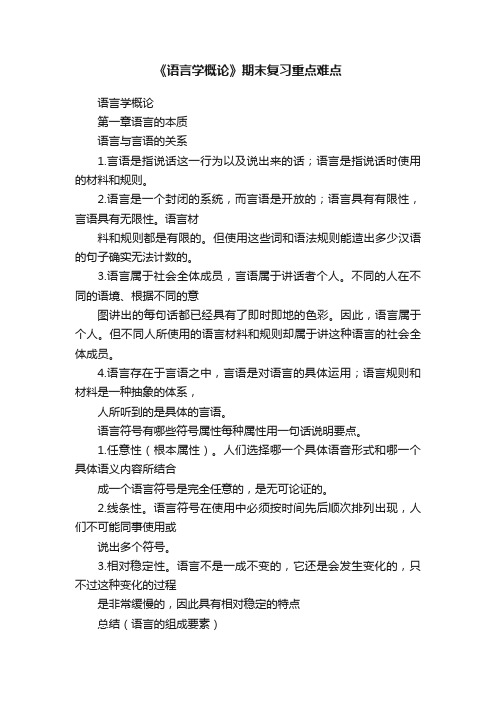
《语言学概论》期末复习重点难点语言学概论第一章语言的本质语言与言语的关系1.言语是指说话这一行为以及说出来的话;语言是指说话时使用的材料和规则。
2.语言是一个封闭的系统,而言语是开放的;语言具有有限性,言语具有无限性。
语言材料和规则都是有限的。
但使用这些词和语法规则能造出多少汉语的句子确实无法计数的。
3.语言属于社会全体成员,言语属于讲话者个人。
不同的人在不同的语境、根据不同的意图讲出的每句话都已经具有了即时即地的色彩。
因此,语言属于个人。
但不同人所使用的语言材料和规则却属于讲这种语言的社会全体成员。
4.语言存在于言语之中,言语是对语言的具体运用;语言规则和材料是一种抽象的体系,人所听到的是具体的言语。
语言符号有哪些符号属性每种属性用一句话说明要点。
1.任意性(根本属性)。
人们选择哪一个具体语音形式和哪一个具体语义内容所结合成一个语言符号是完全任意的,是无可论证的。
2.线条性。
语言符号在使用中必须按时间先后顺次排列出现,人们不可能同事使用或说出多个符号。
3.相对稳定性。
语言不是一成不变的,它还是会发生变化的,只不过这种变化的过程是非常缓慢的,因此具有相对稳定的特点总结(语言的组成要素)两种说法的出发点不同,认识问题的角度不同。
语音、词汇、语法三要素的说法是从组织语言的角度出发的;语音、语义、语法三要素的说法是从分析语言的角度出发的。
两种说法在理论上都有纠结的方面。
1.前一种说法的问题主要在语音与词汇两个因素之间有交叉,因为词的构成的一个方面就是语音;2.后一种说法的问题主要在语法同语义之间有交叉,因为语法内容中包括语法范畴,而语法范畴是由一定语法形式表达的语法意义,比如books中的-s表示复数的语法意义,而语法意义也是语义中的一种。
语言的几层体系的特点(从底层到上层的变化特点)1.语言是由语音、语义、语法三要素组成的系统。
这个系统可以再分为两个层级:帝层和上层。
底层是由一套音位组成的,构成语言的形式系统,不涉及语义。
语言学概论复习指导 整理版

语言学概论知识要点1.语言学的功用4-51)学习语言文字是掌握科学技术,提高文化水平的基础。
2)我国幅员辽阔,民族众多,各民族都有使用和发展自己的语言文字的自由。
3)新兴技术的出现扩大了语言学的应用范围。
2.儿童学习语言的过程14-16儿童学习语言的过程是考察语言与思维的关系的一条很好的途径,学话的过程实际上也就是认识世界的过程,思维发展的过程。
关键两步:独词句的出现——从独词句到双词句独词句体现了词和事物的联系,特别是词指称整类事物的概括性。
双词句体现了造句的基本原理,(词与词之间的关系)就是选择需要的词,按照学会的格式把它们组合在一起。
——实词句——虚词3.语言的符号性质,为什么说语言是一种符号系统?25-30人们用来交际的不是实在的事物,而是代表事物的符号。
词就是一种符号,它能使听话者意识到它所代表的事物或现象。
整个语言就是由这种符号组成的一个系统。
词这样的符号是声音和意义相结合的统一体。
声音是语言符号的物质形式。
征候是事物本身的特征,它代表着事物,可以让我们通过它来推知事物。
符号和自己所代表的事物是两回事,相互之间没有必然的联系。
——语言符号的本质:约定俗成。
符号包含形式和意义。
意义是人们对一类现实现象的概括反映。
音义结合的统一体构成符号,成为现实现象的代表。
音和现实现象没有直接联系。
意义是联系现实现象和音之间的桥梁。
符号能够在使用中重复出现,人们才能根据交际的需要将有限的符号排列组合,说出无限的话来。
所有符号中,语言符号最重要、最复杂。
音位不是符号,因为没有和某种意义相结合。
语言中最小的符号是语素,语素是语言中音义结合的最小单位,词是语言中能够独立使用的符号,句子是符号和符号组装的成品,是符号的序列。
语言符号的最大特点:音义结合的任意性(约定俗成,音与义之间无必然联系,此为形成人类语言多样性的一个重要原因),然而符号的任意性只是就创制符号时的情形而言,一旦进入交际,便对社会成员有强制性。
- 1、下载文档前请自行甄别文档内容的完整性,平台不提供额外的编辑、内容补充、找答案等附加服务。
- 2、"仅部分预览"的文档,不可在线预览部分如存在完整性等问题,可反馈申请退款(可完整预览的文档不适用该条件!)。
- 3、如文档侵犯您的权益,请联系客服反馈,我们会尽快为您处理(人工客服工作时间:9:00-18:30)。
1.phonetics(语音学) A branch of linguistics which studies the characteristics of speech sounds and provides methods for their description, classification and transcription. e.g:p. bilabial, stop.:(1)articulatory phonetics(发音语音学), from the speakers’ point of v iew(2)acoustic phonetics(声学语音学), from the hearers’ point of view(3)auditory phonetics(听觉语音学), from the physical way or means by which sounds are transmitted from one to another.2.pragmatics(语用学),a field of study to take care of that part of meaning of language in use.In many ways, pragmatics is the study of speakers intended meaning, or even the “invisible meaning”. Pragmatics can also be defined as the study of speaker meaning.Micropragmatics(微观语用学):The research on the analyses of larger chunks of language, such as a whole conversation, an article or even a chapter of a novel or one act of a play in the user interaction concerning the mechanisms by which speakers encode their message in skilful ways and how hearers arrive at the intended meanings in spite of the differences between the literal meaning and the intended meaning is called macropragmatics. To study the meaning of such pieces of language in smaller contexts is called micropragmatics.” R eference(指称),deixis(指示),anaphora(回指) and presupposition(预设)” are all topics in this field.3.phonology(音位学):phonology is the description of the systems and patterns of speech sounds in a language(1)phonemes, the smallest phonological unit that can distinguish meaning(eg:sip\zip)2.minimal pairs and sets minimal pairs: a pair of words, identical in every way except for one sound segment in the same position minimal set:a group of words differential by one sound segment in the same position3. free variation(自由变体) when two or more sounds occur in the same position without any apparent change of meaning, they are said to be in free variation (eg: either 的两种发音)Cooperative principle there is a set of assumptions guiding the conduct of conversation this is what called cooperative principle. It means that we should say what is true in a clear and relevant manner.4.Syntax(句法) If we focus on the structure and ordering of components within a sentence, we are studying what is known as the syntax of a language. It means the rules governing the combination of words into sentence.Every sentence is a sequence of words, but not every sequence of words is a sentence.The prescriptive Approach(规定的方法): This view ofgrammar as a set of rules for the “proper” use of a language is st ill to be found today and may be best characterized as the prescriptive approach.The Descriptive Approach(描述性的方法): Linguists collect samples of the language they are interested in and attempt to describe the regular structures of the language as it is used, not according to some view of how it should be used. This is called the descriptive approach1.Structural analysis:its main objective is to study the distribution of linguistic forms in a language.2.Immediate constituent analysis(直接成分分析法): Language is linear and hierarchical. We can analyze language from its largest level to the smallest level, that is from its construction to its constituents by means of substitutability and expansion. The first divisions or cuts of a construction are called immediate constituents and the final cuts as the ultimate constituents. The approach to divide the sentence up into its immediate constituents by using binary cutting until obtaining its ultimate constituents is called immediate constituent analysis.5.Variations of the same phonemes(音位变体)means any different forms of the same phoneme in different phonetic environments.6. Descriptive and prescriptive grammars: descriptive grammars attempt to tell what is in the language, while prescriptive grammars tell people what should be in thelanguage.most modern linguistics are descriptive, it attempts to describe what people accurat ely say. Traditional grammars told people how to use a language. As traditional grammar trie d to lay down rules,they are often called prescriptive. To put it simple, description tells people what it is in a language while prescription tells people what should be in a language.Descripti ve---describe/analyze linguistic facts observed or language people actually use(modern linguistic)Prescriptive---lay down rules for correct linguistic behavior in usinglanguage(traditional grammar)7. duality(二重性) L anguage is a system, which consists of two sets of structures, or two levels at the lower or the basic level there is a structure of sounds, which are meaningless. But the sounds of language can be grouped and regrouped into a large number of units of meaning such as morphemes and words.8. arbitrariness(任意性) one design feature of human language,which refers to the fact that the forms of linguistic signs bear no natural relationship to their meaning.9.morphology(形态学) Morphology, as a branch of linguistics, is thus the study of theinternal structure forms and classes of words.(unfriendly: unhappily, unkindly, unlonely)A morpheme(词素,形态素)is a minimal unit of meaning or grammatical function. eg: tourists(tour,ist,s)Free morphemes(自由词素): A word must contain an element that can stand by itself, that is, a free morpheme, such as talk, car, friend.Lexical morphemes(open class of word):词汇语素(look, love, happy)Functional morphemes(closed class of words):功能语素(but, when, the)Bound morphemes: bound morphemes are actually affixes(词缀)Derivational morphemes(派生词缀) which are used to make new words in the language and are often used to make words of a different grammatical category from the stem.(-er, -ness, -ly)Inflectional morphemes(曲折词缀):which are not used to produce new words, but rather to show aspects of the grammatical functional of a word.(-’s, -s, -ed, -ing, -er, -est)10. assimilation(同化) sounds belonging to one word or one syllable (音节)can cause changes in sounds belonging to neighboring words or syllables,this is called assimilation. 11. tone language(声调式语言)language in which the meaning of a word depends on the pitch at which it is uttered.Chinese is tone language while English is not. In English, tone is regarded as a phonological f eature distinguish meaning.12.diacritics(变音符号) a sign placed above or below a character or letter to indicate that it has a different phonetic phonetic value, is stresses, or for some other reason.13. root(词根) A word must contain an element that can stand by itself, that is, a free morpheme, such as talk. Such an element is called a root. A word may contain more than one root, in which case it is a compound word , eg: bookshop, blackbird14. Blending(混成构词法) A single new word can also be formed by combing two separate forms. This process is usually called blending. Typically, blending is finished by taking only the beginning of one word and joining it to the end of another word.15. Acronym(首字母组合词) some new words are formed from the first letters of a series of words. They are pronounced as single words. Words of this kind are called acronym. Such as UNESCO, NATO16.Derivation(派生法), Which is done by adding affixes to other words or morphemes. In contrast to compounding, a derivational word consists of at least a free morpheme and abound morpheme.17. compounding(复合法). Words like typewriter, workshop, tractor-driver are formed by putting two words together. This way of building new words is called compounding. Compounding is a productive way of word formation. By means of compounding, two free morphemes are combined to form a compound.18. Stress(重音) when a word has more than one syllables, one of them will be pronounced with more prominence than others. This brings us to another speech sound phenomenon, that of stress.Nouns have first syllable stress, verbs second.19. syllable(音节) these units, which are often longer than one sound and smaller than a whole world, are called syllables.20. prototype(原型) the members of a particular community which are considered as the best examples of a lexical category are said to be prototype. According to prototype theory, people decide whether an en tity belongs to a category by comparing that entity with the prototype. For example, sparrow c an be said the prototype of birds.21. lexical gap(词汇空缺) the absence of a word in a particular place in a semantic field of a language is called lexical gap. For instance, in English there is no singular noun that covers both cow and bull.22. semantic field (语义场) a set of words with an identifiable semantic connection23. sense and reference(意义和指称) sense and reference are two different, though related, aspects of meaning.Sense is to be defined in terms of relationships which hold between the linguistic elements themselves(mostly words), it is concerned with intralinguistic(语言内部的关系) relations eg: bachelor and married have the sense relationship of bachelor=never married Reference deals with the relationship between the linguistic elements ( words, sentences ,etc) and the non-linguistic world of experience. Eg: things, actions, events and qualities.24. suffix(后缀) The suffix, which is added to the end of a word, and which usually changes the part of speech of a word.25. recursiveness(递归性)Recursion is the process a procedure goes through when one of the steps of the procedure involves invoking the procedure itself. Recursion in linguistics enables 'discrete infinity' by embedding phrases within phrases of the same type in a hierarchicalstructure.26. cohesion(衔接) cohesion is an important field of study in discourse(谈话,谈论) analysis. it refers to the grammatical and \or lexical relationships between the different elements of a discourse. This may be the relationship between different sentences or between different parts of a sentence.Five types of cohesive devices: reference, substitution(替代,替换), ellipsis(省略), conjunction, lexical cohesion27. coherence(连贯性) coherence refers to the relationships which link the meanings of utterances in a discourse.28. reflective meaning(反射意义) is the meaning which arises in cases of multiple conceptual meanings, when one sense of a word forms part of our response to another sense.(the nuclear family, the nuclear age)29. associative meaning(联想意义)Is the essential and inextricable part of what language is,and is widely regarded as the central factor in verbal communicatiIs the essential and inextricable part of what language is,and is widely regarded as the central factor in verbal communication.It means the meaning of words may be discussed in terms of what they denote or refer to.30. ambiguity (消解歧义)The lexical ambiguity of a word or phrase pertains to its having more than one meaning in the language to which the word belongs.31. iconicity(象似性,形象性) iconicity is the conceived similarity or analogy between the form of a sign (linguistic or otherwise) and its meaning, as opposed to arbitrariness. Iconicity of order (顺序的象似性)refers to the similarity between temporal events and the linear arrangement of elements in a linguistic construction. It reflects the consistency of language with human cognition and the objective world..eg: I came, I saw, I conquered.(a.He opened the bottle and poured himself a glass of wine. b. He poured himself a glass of wine and opened thebottle.)Iconicity of distance accounts for the fact that things which belong together conceptually tend to be put together linguistically, and things that do not belong together are put at a distance.(a. I killed the chicken. B. I caused the chicken to die.) Iconicity of distance can also give a satisfactory explanation to the sequence of multi-adjectives before a noun.Iconicity of complexity. The phenomenon that linguistic complexity reflects conceptual complexity. Iconicity of complexity accounts for our tendency to associate more from withmore meaning and, conversely, less form with less meaning. This idea has long been an important aspect of markedness theory. Marked forms and structures are typically more complex than unmarked ones.(a. On the Brighten train from Victoria I met her. b. On the Brighten train from Victoria I met the girl from next door.)32. Allomorpheme(语素变体)some morphemes are realized by more than one morphemes depending on the context they occur. Allomorphemes are phonological variants of the same morpheme.33.Tree diagram: S=NP(Art+N)+VP(V+NP[Art+N])34. Illocutionary acts: the extra meaning of the utterance produced on the basis of its literal meaning.35. language: a system of arbitrary vocal symbols used for human communication.36. linguistics: the scientific and systematic study of language. 37. elision: the leaving out of a sound or sounds in speech.38.pragmatics:a branch of linguistics that studies language in use. 39. stem:the base to which one or more affixes are attached to create a more complex form that may be another stem or a word.40.semetic role: the way in which the referent of a noun phrase is involved in the situation described or represented by the clause, for example as agent, patient, or cause.。
